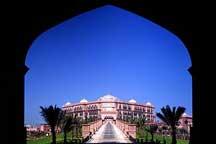 May. 6, 2025
May. 6, 2025
Weather
The Kazak ethnic minority
2009-08-07 10:57 BJTThe Kazaks are Muslims. Though there are not many mosques in the pastures, Islam exercises a great influence upon their social life in all aspects. Their religious burdens used to be heavy. They had to deliver religious food grain and animal taxes in accordance with Islamic rules. If they wanted to invite mullahs for prayers on occasions of festivals, wedding, burial ceremonies or illnesses, they had to present given amounts of money or property.
The Kazaks' festivals and ceremonies are related to religion. The Corban and Id El-fitr festivals are occasions for feasts of mutton and mutual greetings. The Nawuruz Festival in the first month of the lunar calendar is a grand occasion to say good-bye to the old, usher in the new, and hope for a better year in stockbreeding. Every family entertains with "kuji," a food made of mutton, milk dough, barley, wheat and other delicacies. They give feasts when there are births, engagements or weddings.
The Kazaks, men and women alike, are good horse riders. Young men like wrestling and a game in which horsemen compete for a sheep. There are horsemanship displays on the grasslands during festivals. The young people like to play a "girl-running-after-boy" game. The boys and girls ride their horses to an appointed place; the boys can ¡°flirt with¡± the girls on the way. However, on the way back, the girls chase the boys and are entitled to whip them if they can as a way of "vengeance." Such merry-making more often than not terminates with love and marriage.
This ethnic minority has its own rich literary heritage. As there were many illiterates, folk literature handed down orally was quite developed. After liberation, ballad singers, or "Akens," made great efforts to collect, study and re-create old verses, tales, proverbs, parables and maxims. Many outstanding Kazak classic and contemporary works have been published in the Kazak language.
Kazak music and dance also have their own unique features and are very popular. The Kazaks like summer the best, terming it merry-making time. They often sing and dance throughout summer nights on the pastures. The two-stringed instrument is their favorite.
Tribal Life
All Kazaks belonged to definite clans before 1949. They and their area were divided into three hordes (ordas): the Great Horde, Middle Horde and Little Horde -- or the Right, Left and Western branches as the Qing government documents referred to them. The Middle Horde was the most powerful, with the largest number of people and most complete clan lineage. The Kazaks in China mostly belonged to the Great and Middle Hordes.
The clans were formally blood groups of different sizes. The smallest productive organization and nomadic community within the clan was the "Awul," people with the same grandfather or father; sometimes they included people without any blood ties, mostly dependent poor herdsmen from without. So, there was a sharp contrast of wealth in the "Awul" of three, five, a dozen or more families. Owing to wars, migration or other causes, such internal blood relations became very loose.
The ruling group was composed of the nobility, tribal chiefs, herd owners and "Bis." The Bis generally came from a rich herdsman's family, were well-versed in the laws, customs and eloquence, and were generally regarded as qualified mediators. The ethnic group did not have any written law, but each clan had its own common law which protected private property, the privileges of the tribal chiefs, and tribal solidarity and unity. Whenever there were disputes over property, marriage or other matters, the "Bi" mediated and handled them in accordance with the clan law, generally practicing "punishment by nine," i.e., compensation of nine head of animals paid by the loser to the winner of the lawsuit.
The Kazak clan organization was a combination of the feudal system of exploitation and the clan patriarchy. The ruling class plundered the people economically and enjoyed political privileges. The majority of the poor herdsmen were deprived of all rights whatsoever.
 Mail
Mail Share
Share Print
Print


 Video
Video









 2009 China Central Television. All Rights Reserved
2009 China Central Television. All Rights Reserved